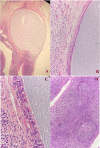Nasopharyngeal Branchial Cleft Cyst: A Rare Case Report and Literature Review
- PMID: 37706148
- PMCID: PMC10497237
- DOI: 10.7759/cureus.43432
Nasopharyngeal Branchial Cleft Cyst: A Rare Case Report and Literature Review
Abstract
Branchial cleft cysts are birth defects that happen when the first through fourth pharyngeal clefts do not close properly and most of these cysts develop from the second cleft. Second branchial cleft cysts are almost always in the neck, so it is rare for them to present in the nasopharynx. We report an extremely rare case of a branchial cleft cyst that is located in an unusual site in the nasopharynx in a 36-year-old male with no prior medical history. Computed tomography scan findings showed non-enhancing thickening of the right side mucosal-pharyngeal space, obliterating the fossa of Rosenmuller with no invasion or erosion. The patient was admitted for nasopharyngeal mass excision, and the mass was sent for histopathology. When a cystic lesion is noted in the lateral nasopharynx, branchial cleft cysts should be on the list of possible diagnoses. Surgery is primarily the treatment. The marsupialization approach is a simple way to treat nasopharyngeal branchial cleft cysts as it is safe and has limited complications.
Keywords: adult male; branchial cleft cysts; ct; nasopharynx; rosenmuller.
Copyright © 2023, Alzaidi et al.
Conflict of interest statement
The authors have declared that no competing interests exist.
Figures


References
-
- Branchial cleft cysts in adults. Diagnostic procedures and treatment in a series of 18 cases. Papadogeorgakis N, Petsinis V, Parara E, Papaspyrou K, Goutzanis L, Alexandridis C. Oral Maxillofac Surg. 2009;13:79–85. - PubMed
-
- Traumatic and nontraumatic emergencies of the brain, head, and neck. Barest GD, Mian AZ, Nadgir RN, Sakai O. https://studylib.net/doc/25755047/emergency-radiology-the-requisites Emergency Radiology. Soto JA, Lucey BC;Mosby:0.
-
- [Mode of presentation of fistula of the first branchial cleft] Possel L, François M, Van den Abbeele T, Narcy P. Arch Pediatr. 1997;4:1087–1092. - PubMed
Publication types
LinkOut - more resources
Full Text Sources
